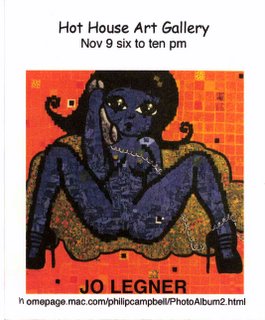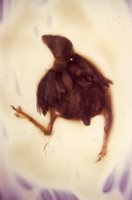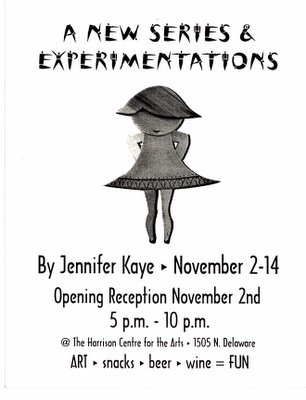Mary Lee Pappas
Art whiners be warned. Hoosiers are buying original art by living artists. Local gallery owners can vouch for what Greg Lucas, owner of G.C. Lucas Gallery in the Meridian-Kessler neighborhood, calls “a very strong art market.” Granted, certain styles of grittier, edgier work are harder to sell, but people are still willing to spend money on art here.
Local art galleries are welcoming, low-pressure places to visit. But Doris V. Hails, curator at Woodburn and Westcott, has reported that guests have asked if there is an admission charge to peruse her gallery space. The general public in Indianapolis has little experience at visiting galleries, so it is not uncommon for gallery owners to receive calls like, “What is the proper attire to wear to an opening?” and, “Are children welcome?”
No admission is charged at galleries. Gallery art openings are not black-tie affairs, so come as you are comfortable, whether that means jeans, suit or whatever. Well-behaved children, accompanied by adults, are absolutely welcome, although Phil Campbell, owner of Hot House Art Gallery, artist and father, advises, “Come with an open mind,” as nudity in art is a time-honored standard.
It is perfectly fine to visit a gallery to browse. Simply walking into a gallery is not a commitment to purchase, so set those checkbook anxieties aside. “There are some people that come in for an art fix,” Hails says.
“It’s a great thing when people come in just to view the art,” David Kadlec, owner of Eye Blink Gallery in Fountain Square, observes. “By picking up on the stories artists are telling they can open up conversations with their family, their kids. They are taking part in the cultural community.”
Nora Campbell, art director at the Domont Studio Gallery near Fletcher Place, agrees. “All galleries want people to feel comfortable. The doors are always open to come in and look and appreciate. We’re just glad people come in,” adding that a gallery’s role should be to educate the public about art.
Art education dialogue is more accessible in a gallery than at a hush-hush museum. Instead of blindly scanning a wall of art in a mausoleum atmosphere, an open conversation can be had at a gallery, and usually with the owner. “I’m here for that!” Hails says.
Greg Lucas has found that people are intimidated by art vocabulary, so he engages and educates his gallery guests about generic art language, like the meaning of painting “loose” versus “tight” and “modern” versus “contemporary.” It is completely acceptable to state that you like a work of art because it’s “neat” or “pretty.” The ability to rattle off historical, period-specific, academic art jargon won’t impress anyone and will not necessarily enhance an emotional response to any artwork. And art is all about emotional response — especially for the virgin buyer.
Art connoisseur, or not, the most important criterion for an art purchase should be to like and be attracted to a piece. Kadlec describes this motivator as “people being drawn to the statement being made by the artist.” It’s OK to want something because it’s beautiful or is reminiscent of a trip to wherever, whenever, too. In truth, the numero uno reason people purchase art is because it reminds the buyer of something and provides an emotional outlet.
Lucas sums it up best: “It’s an emotional thing.” He explains that people are not buying art to match their couch. “The point of a painting is that it should stand out from the sofa.”
A piece of art cannot be judged by its price tag alone. Worthy and desirable art is not indicated by an exorbitant price or an artist’s tombstone. Price usually reflects innumerable can’t-put-your-finger-on factors. For instance, an artist’s work may be priced high because he can command that price in other cities or because she has been producing work for 35 years and shouldn’t sell for less.
A low-priced painting can be of greater artistic quality than a higher priced piece. Price points for high quality, original art run across the board, so everyone can afford something. “I remain convinced that it’s not the dollar amount that sells the work. It’s a position of love,” Kadlec says of art purchases.
Nora Campbell stresses that a customer will “have to love it because they’ll be living with it.”
Buying an original piece of art from a local gallery contributes to local economy and the local arts community. It is a contribution to the financial and professional success of the artist and gallery. Art by working, living artists naturally appreciates over time but can’t be guaranteed — so purchasing for investment is discouraged. The majority of people who purchase art aren’t interested in investment anyway. Kyle Blevins, a photographer who recently showed his work at Eye Blink, says that by purchasing original art “you own your art community. It’s a personal investment.”
Most galleries offer financing. Lucas says, “We work with [buyers] to help them own the painting.” Clients are offered discounts on repeat purchases and are encouraged to acquire art by the same artists. He also sells gift certificates, has painting savings plans and offers discounts on individual pieces if they are available. Some galleries like Kadlec’s have a fixed price policy. “It’s rare that anyone has asked for a discount,” Kadlec says — but don’t be embarrassed to inquire.
“We have to,” Nora Campbell says of financing. “Original art is not a mass market. Most paintings are more than what people can just write a check for.”
Phil Campbell notes that the price range for personal spending on art “is all over the place. The majority spend between $1,200 to $1,500 on average.”
At Woodburn and Westcott, I witnessed an unassuming patron purchase an Indiana landscape by Lynn Thomsen for $2,200. Stanley Woodburn Hails, gallery manager of Woodburn and Westcott, says, “You wouldn’t have a clue what a customer looks like,” observing that customers are as diverse as the artwork itself.
Doris Hails admits that some people are hesitant about purchasing real art for themselves because “It doesn’t seem normal to have real art on their walls.”
Phil Campbell agrees, “They want what’s safe, what their friends have, what blends into the woodwork.” But original art can be more affordable than framing a poster print — and it’s a one-of-a-kind.
A limited edition, prepackaged Thomas Kinkade print-transfer-to- canvas from the mall (one of 3,900 made to simulate a real painting) will cost $640 and up, depending on the size and the edition. An original figurative watercolor work by Phil Campbell, on the other hand, is only $325. A consumer who buys a big-name Kinkade because it feels safe (all the neighbors have one next to their Nancy Noels) isn’t getting a bargain. In 50 years, the piece a local museum (say the Indianapolis Museum of Art or the Indiana State Museum) would consider acquiring in exchange for a tax deduction, or the piece your grandchildren would be happy to inherit, is more likely to be an original that has a sense of history and withstands the test of time. In 20 years, those Kinkades will probably be on sale in Goodwills and Salvation Army shops.
Some artists have inadvertently altered the face of local art history with their unique contributions. The significance of their accomplishments, their styles, techniques and local roots all make a piece of original art valuable.
A buyer who buys based on name alone is an uninformed collector. There are, however, a few notable art personalities who are recommended for your art consumption. Nhat Tran, whose studio is located next to the Midland Antique Mall, is an artist whose lacquer works have been exhibited and acquired by the Smithsonian for their permanent collection. Tran uses an unusual and very toxic ancient lacquer technique to produce work that is influenced by her Asian roots, but inspired by the West. The Hoosier Salon represents the amazing impressionistic oil paintings of Patricia Rhoden Bartles. Bartles’ visions of Southern Indiana landscape have reinvented the familiar Hoosier Group ideals. John Domont is another Indiana landscape artist who recently finished two 15-foot commission pieces for the Riley Children’s Hospital in addition to having two paintings acquired by the Indiana State Museum for their permanent collection. They are but a few artists in Indianapolis who justify Doris Hails’ claim that “We are a wealthy city in terms of the arts.”
Peruse NUVO’s Galleries space in the Calendar for the most recent shows in the city. Scribble down those telephone numbers and call with all your art inquires. Visit and ask more questions. Don’t be discouraged if you are immediately in love with the first artwork you see.
Phil Campbell, David Kadlec, Doris Vlasek Hails, Doris Hails, Ann Leggett, G.C. Lucas Gallery, Greg Lucas, Hot House Art Gallery, Eye Blink Gallery, Nora Campbell, John Domont, Domont Studio Gallery, Indianapolis Museum of Art, Newfields, Nancy Noel, Patricia Rhoden-Bartles, That Tran, Hoosier Group, Indiana State Museum, Kyle Blevins, Lynn Thompsen, Stanley Woodburn Hails, Midland Antique Mall, Hoosier Salon, Riley Children's Hospital






